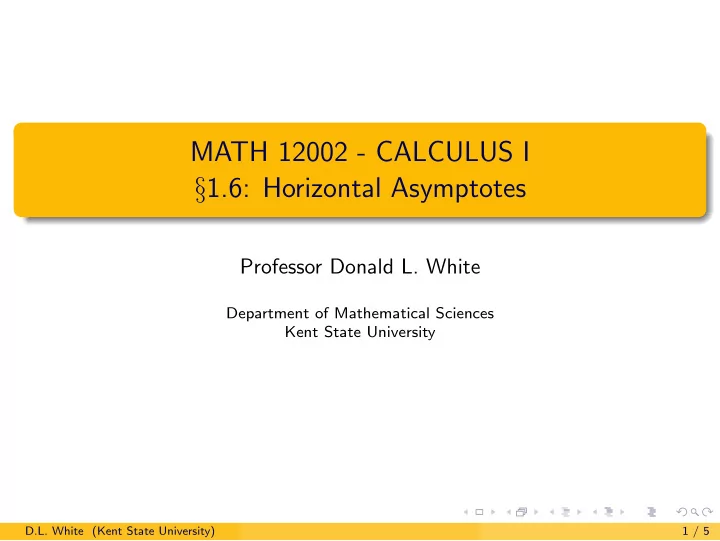

MATH 12002 - CALCULUS I § 1.6: Horizontal Asymptotes Professor Donald L. White Department of Mathematical Sciences Kent State University D.L. White (Kent State University) 1 / 5
Horizontal Asymptotes Horizontal asymptotes are very closely related to limits at infinity. Definition Let y = f ( x ) be a function and let L be a number. The line y = L is a horizontal asymptote of f if x → + ∞ f ( x ) = L or lim x →−∞ f ( x ) = L . lim Notes: The definition means that the graph of f is very close to the horizontal line y = L for large (positive or negative) values of x . A function can have at most two different horizontal asymptotes. A graph can approach a horizontal asymptote in many different ways; see Figure 8 in § 1.6 of the text for graphical illustrations. In particular, a graph can, and often does, cross a horizontal asymptote. Let’s emphasize this point to avoid problems later: D.L. White (Kent State University) 2 / 5
Horizontal Asymptotes THERE’S NO REASON — HERE’S MY POINT, DUDE — THERE’S NO # ∧♣ %!*& REASON WHY THE GRAPH OF A FUNCTION CAN’T CROSS A HORIZONTAL ASYMPTOTE!! D.L. White (Kent State University) 3 / 5
Horizontal Asymptotes Our general result on limits at infinity of rational functions implies the following. Theorem Let f ( x ) = P ( x ) Q ( x ) be a rational function (P ( x ) , Q ( x ) are polynomials). If deg P ( x ) = deg Q ( x ) , then the horizontal asymptote of f ( x ) is y = p q , where p, q are the leading coefficients of P ( x ) , Q ( x ) , respectively. If deg P ( x ) < deg Q ( x ) , then the horizontal asymptote of f ( x ) is y = 0 (the x-axis). If deg P ( x ) > deg Q ( x ) , then f ( x ) has no horizontal asymptote. Note: In general, a function need not have the same horizontal asymptote at both −∞ and + ∞ . (See Exercise 1.6.34 in the text, for example.) D.L. White (Kent State University) 4 / 5
Examples 1 The rational function f ( x ) = 4 x 3 − 7 x 2 + 2 5 − 9 x 3 has both numerator and denominator of degree 3. The numerator has leading coefficient 4, and the denominator has leading coefficient − 9. Therefore, the horizontal asymptote (at both + ∞ and −∞ ) is y = 4 − 9 = − 4 9. 2 The rational function f ( x ) = 7 x 4 + 3 x 2 + 5 6 x 5 − x has numerator of degree 4 and denominator of degree 5. Since the degree of the numerator is less than the degree of the denominator, the horizontal asymptote is y = 0. D.L. White (Kent State University) 5 / 5
Recommend
More recommend